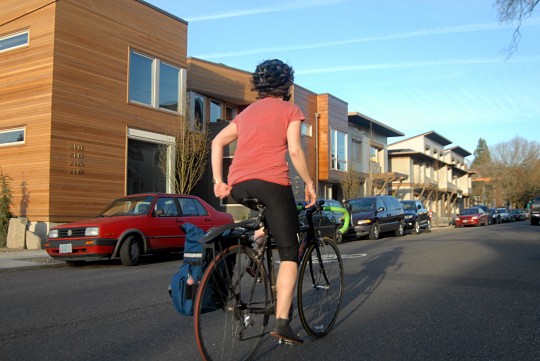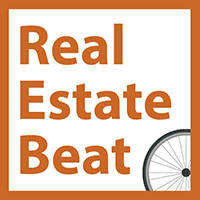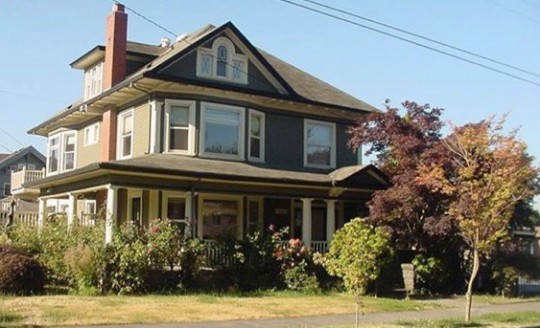
(Photo: M.Andersen/BikePortland)
A slate of ideas for increasing Portland’s housing supply with fewer visual changes to its central-city neighborhoods is getting warm reviews from influential neighborhood association leaders.
The list of policy proposals, compiled by local indie developer Eli Spevak last month after a conversation with Tamara DeRidder of the Rose City Park Neighborhood Association, includes concepts such as legalizing internal divisions of existing houses and scaling transportation, sewer and parks fees based on home size.
The general theme of the proposals: allowing more housing in Portland that offers more density than single-family houses but less than four-story apartment buildings.
“There’s different ways of creating affordability that we haven’t really brokered with,” DeRidder said in an interview Monday. “There’s a massive in-between.”
Spevak developed the concepts as a response to the seemingly ever-rising demand for homes in Portland’s bikable, walkable, transit-rich neighborhoods that were developed before the automotive age. Widespread construction in those areas hasn’t been enough to keep up with population growth, meaning that many households are already sharing homes in order to keep up with fast-rising rents while others are being priced out of the areas.
Many neighborhood associations, meanwhile, say demolition of old homes is also a significant policy problem.
Spevak says that’s because developers’ easiest way to maximize profit in a single-family neighborhood is to build the largest possible house and market it based on its massive square footage. He hopes to create a different road to profit: putting multiple small units on a property.
Internal home divisions — which Spevak says were legal for any house in Portland before World War II, leaving many still in place in older neighborhoods — would be plausible projects for current homeowners looking to become small-scale developers themselves.
“You’ve got aging Baby Boomers who are looking for ways that they can also put another person on their property,” said DeRidder, who works as a private planner by profession. “If you’re able to do it internal to the existing structures, then you save a lot of money and you don’t have to charge as much.”
Advertisement
The Sunnyside Neighborhood Association voted last year to endorse an earlier draft of Spevak’s policy proposals.
Heather Flint Chatto of the Richmond Neighborhood Association is a critic of Portland’s strategy of allowing significantly more intense development on larger streets such as Division than in the surrounding single-family neighborhoods.
“By concentrating it all on our corridors and centers we’re kind of missing some less impactful townhouse-style designs,” Flint Chatto said. “That has a much lesser impact on our adjacent development.”
“There’s this deep sense of loss and trauma that people are going through right now, I think citywide,” she went on. “At every turn I see a really huge modern building.”
Flint Chatto, who also works professionally as a planner, said her main concerns about new development are “congestion, increased crime, loss of affordability,” and that all of those would be lessened if new investment were scattered more evenly through neighborhoods rather than concentrated on corridors.
“It’s scary to me how things are going in Portland in terms of affordability, and I think it should be a front-burner priority.”
— Linda Nettekoven, Hosford-Abernathy Neighborhood District Association
She said the rapid transformation of Division in the 30s blocks has meant “going from $10 jeans on Division to $175 jeans on Division in the space of a year.”
“You run into people at the food carts because those are the businesses that people can afford,” she said. “They can’t afford to live and use the businesses in the neighborhood now.”
Linda Nettekoven of the Hosford-Abernathy Neighborhood District Association agreed.
“I think at the moment it’s scary to me how things are going in Portland in terms of affordability, and I think it should be a front-burner priority,” she said.
Nettekoven said Spevak’s goal of increasing housing supply without major visual changes to a neighborhood might depend on projects being “in the hands of the right kind of builder” and worried that rules for increasing the number of homes on a property “can be an excuse to do something that doesn’t necessarily have a benefit.”
But she said that in the right circmstances, Spevak’s ideas seemed appealingly familiar.
“A lot of those things already exist in Ladd’s Addition, for example, where I happen to live,” Nettekoven said. “You’ve got houses of different age and scale mixed together and hopefully harmoniously.”
— The Real Estate Beat is a regular column. You can sign up to get an email of Real Estate Beat posts (and nothing else) here, or read past installments here. This sponsorship has opened up and we’re looking for our next partner. If interested, please call Jonathan at (503) 706-8804.



